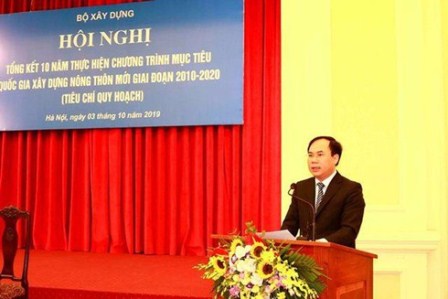Nearly 100 percent of rural communes have planning
Saturday, 10/05/2019 13:00
The ratio of rural communes with their own planning has risen from 23.1 percent in 2010 to 83.1 percent in 2013 and 99.7 percent today, according to Deputy Minister of Construction Nguyen Van Sinh.

Deputy Minister of Construction Nguyen Van Sinh addresses the event
At a conference in Hanoi on October 3 to review the implementation of the criteria on planning as part of the National Target Programme on New-Style Rural Area Building, Sinh said the Ministry of Construction has coordinated with localities to deal with any difficulties they face in designing new-style rural areas.
He said that from 2010-2015, planning had focused on developing new residential areas and improving existing areas in each commune.
For the 2016-2020 period, the Ministry of Construction was assigned to help localities develop regional plans, ensuring the harmony between rural and urban development, he noted.
Planning is the first among the 19 criteria in the National Target Programme on New-Style Rural Area Building, in which construction planning must be prioritised to lay the foundation for the investment and development of socio-economic infrastructure in rural areas, ensuring sustainable rural building.
In the 2016-2020 period, the programme aims to modernize and industrialise agricultural and rural areas.
Vice Director of the Department of Construction of Lam Dong province Bui Quang Son said that it is necessary to implement detailed planning to attract investment and create motivation for economic development, while applying stricter punishments for violations of land use.
Deputy Minister of Agriculture and Rural Development Tran Thanh Nam said that as of September this year, 4,554 communes, or 51.16 percent of the country’s total communes, had been recognised as new-style rural areas, while on average 15.32 criteria have been met.
The five-year target of the programme has been completed two years ahead of schedule, he added.
Nam proposed revisions of regulations and guidelines in rural planning, construction and management to suit specific regions and meet sustainable development demands.
Source: vov